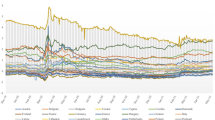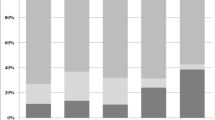Abstract
We study the market quality of Italian sovereign bonds during the COVID-19 pandemic, revealing its direct impact (represented by COVID-19 hospitalizations) and its indirect impact (channeled by the ECB monetary policy) on heightened volatility and deteriorated liquidity conditions during the first COVID-19 wave. We also uncover an additional channel by which the pandemic was costly for taxpayers: the surge of the auction premium. Our analysis shows that subsequent monetary policy measures effectively reduced volatility and the size of the premium during the second wave of the pandemic.








Similar content being viewed by others
Explore related subjects
Discover the latest articles and news from researchers in related subjects, suggested using machine learning.Notes
All times in this paper refer to the Central European Time zone (CET).
MOT differs from MTS BondVision, the wholesale market for Italian Treasuries, in the size of lots traded (at least 2 million euros of lot size in MTS).
To check for robustness, we used alternative variables such as the number of new cases, the number of new positive testings, the number of new hospitalizations in intensive therapy and the ratio between positive and total number of tests. In all these cases, results are broadly in line with the proposed analysis. As a robustness check, we also explored the effect of interaction terms for past illiquidity affecting future volatility and vice versa, but these terms turned out not to be statistically significant.
An additional amount of 1.05, 0.119, 0.181, and 0.3 billion euros was allocated in a supplementary auction the following day. Since the price in the auction is fixed at the price of the ordinary auction, no primary dealers requested additional BTPs because the bond prices experienced a significant decline on the subsequent day, making the secondary market much more favorable than the primary market.
References
Alberola-Ila E, Cheng G, Consiglio A, Zenios SA (2022). Debt sustainability and monetary policy: the case of ECB asset purchases. BIS Working Paper N. 1034
Amihud Y (2002) Illiquidity and stock returns: cross-section and time-series effects. J Finan Markets 5(1):31–56
Beetsma R, Giuliodori M, de Jong F, Widijanto D (2016) Price effects of sovereign debt auctions in the euro-zone: The role of the crisis. J Finan Intermed 25:30–53
Beetsma R, Giuliodori M, Hanson J, De Jong F (2018) Bid-to-cover and yield changes around public debt auctions in the euro area. J Banking Finan 87:118–134
Beetsma R, Giuliodori M, Hanson J, De Jong F (2018) Cross-border auction cycle effects of sovereign bond issuance in the euro area. J Money, Credit Banking 50(7):1401–1440
Bellia M (2020) Intraday pricing and liquidity of Italian and German treasury auctions. Working Paper
CONSOB (2020) Bollettino statistico n. 17
Corsi F (2009) A simple approximate long-memory model of realized volatility. J Finan Econ 7:174–196
Díaz A (2009) Retail investors and the trading of Treasury securities. J Finan Serv Res 36:45–63
Duffie D (2020) Still the world’s safe haven? – redesigning the U.S. Treasury market after the COVID-19 crisis. Hutchins Center Working Paper Number 62, Brookings Institution
European Central Bank (2020a) ECB announces 750 billion euro Pandemic Emergency Purchase Programme (PEPP). https://www.ecb.europa.eu/press/pr/date/2020/html/ecb.pr200318_1~3949d6f266.en.html. Accessed: 2020-10-23
European Central Bank (2020b). Monetary Policy Decisions, 29 October 2020. https://www.ecb.europa.eu/press/pr/date/2020/html/ecb.mp201029~4392a355f4.en.html. Accessed: 2020-10-23
Flora M, Renò R (2022) V-shapes. Working paper
Fontaine J-S, Garcia R (2012) Bond liquidity premia. Rev Finan Stud 25(4):1207–1254
Fontaine J-S, Nolin G (2019) Measuring limits of arbitrage in fixed-income markets. J Finan Res 42(3):525–552
He Z, Nagel S, Song Z (2022) Treasury inconvenience yields during the COVID-19 crisis. J Finan Econ 143(1):57–79
Kolokolov A, Renò R (2024) Jumps or staleness? J Business Econ Stat 42(2):516–532
Lane PR (2020) The macroeconomic impact of the pandemic and the policy response. https://www.ecb.europa.eu/press/blog/date/2020/html/ecb.blog200804~b2c0f2115a.en.html. Accessed: 2020-10-23
Lou D, Yan H, Zhang J (2013) Anticipated and repeated shocks in liquid markets. Rev Finan Stud 26(8):1891–1912
Panzarino O, Potente F, Puorro A (2016) BTP futures and cash relationships: a high frequency data analysis. Bank of Italy Temi di Discussione (1083)
Ranaldo A, Santucci de Magistris P (2021) Liquidity in the global foreign exchange market. Working Paper
Schneider M, Lillo F (2019) Cross-impact and no-dynamic-arbitrage. Quant Finance 19(1):137–154
Schrimpf A, Shin HS, Sushko V (2020) Leverage and margin spirals in fixed income markets during the COVID-19 crisis. BIS Bulletins 2
Sigaux J-D (2024) Trading ahead of Treasury auctions. J Banking Finance 158:107032
Acknowledgements
Any views expressed are solely those of the authors and so cannot be taken to represent those of the Bank of England or to state Bank of England policy. This paper should therefore not be reported as representing the views of the Bank of England or members of the Monetary Policy Committee, Financial Policy Committee or Prudential Regulation Committee. We thank the participants of the Financial Engineering Workshop at Cass Business School (27 January 2021), the Financial Computing and Analytics Group Seminar at University College London (10 March 2021), the 24th Central Bank Macroeconomic Modeling Workshop (13 October 2021) and the 2021 International Finance and Banking Society (IFABS) Oxford Conference (15 September 2021) for comments. We also thank Mario Bellia, Nicholas Vause, the Editorial Board of Bank Underground and anonymous referees for valuable comments. R. Renò acknowledges PRIN funding from MIUR, Italy, HiDEA Project 2017RSMPZZ. R. Renò acknowledge research support from the University of Verona. R. Renò and M. Flora thank Long-Term Investors@UniTo for financial support. We thank Borsa Italiana S.p.A. for providing the data set. Errors and omissions are our own.
Author information
Authors and Affiliations
Corresponding author
Ethics declarations
Conflicts of Interests
None of the Authors has any conflict of interest or any competing interest to declare.
Additional information
Publisher's Note
Springer Nature remains neutral with regard to jurisdictional claims in published maps and institutional affiliations.
Rights and permissions
Springer Nature or its licensor (e.g. a society or other partner) holds exclusive rights to this article under a publishing agreement with the author(s) or other rightsholder(s); author self-archiving of the accepted manuscript version of this article is solely governed by the terms of such publishing agreement and applicable law.
About this article
Cite this article
Ferrara, G., Flora, M. & Renò, R. The Impact of COVID-19 on Italian Sovereign Bond Market Quality. J Financ Serv Res 67, 55–71 (2025). https://doi.org/10.1007/s10693-024-00437-7
Received:
Revised:
Accepted:
Published:
Issue Date:
DOI: https://doi.org/10.1007/s10693-024-00437-7




